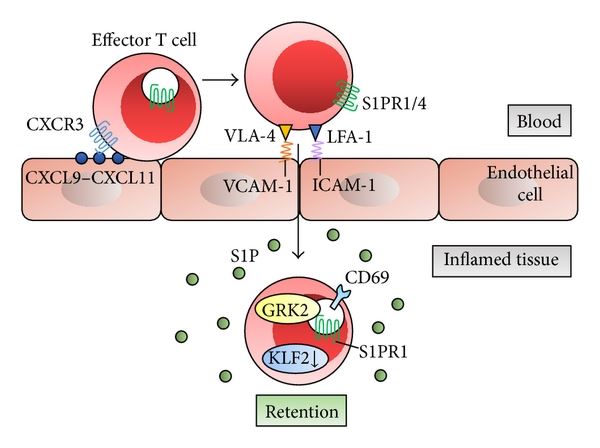Introduction of S1PR4
Sphingosine 1-phosphate receptor 4 (S1PR4), also known as S1P receptor or Edg-6, is encoded by the S1PR4 gene. It belongs to the G-protein-coupled receptor (GPCR) family which has been extensively studied during the past few decades because it offers numerous possibilities for therapeutic applications. Sphingosine-1-phosphate (SPP) is a metabolite of complex sphingolipids that acts as both a second messenger and as a high-affinity ligand for cell surface receptors. SPP receptors specifically bind SPP or the related lipid. S1PR4 is expressed in lymphoid and hematopoietic tissue as well as the lung. Recent studies show that SPP binds specifically to S1PR4 and activates the mitogen-activated protein kinase (MAPK) signal transduction pathway.
| Basic Information of S1PR4 | |
| Protein Name | Sphingosine 1-phosphate receptor 4 |
| Gene Name | S1PR4 |
| Aliases | S1P receptor 4, S1P4, S1P receptor, Edg-6 |
| Organism | Homo sapiens (Human) |
| UniProt ID | O95977 |
| Transmembrane Times | 7 |
| Length (aa) | 384 |
| Sequence |
MNATGTPVAPESCQQLAAGGHSRLIVLHYNHSGRLAGRGGPEDGGLGALRGLSVAASCLVVLENLLVLAAITSH MRSRRWVYYCLVNITLSDLLTGAAYLANVLLSGARTFRLAPAQWFLREGLLFTALAASTFSLLFTAGERFATMV RPVAESGATKTSRVYGFIGLCWLLAALLGMLPLLGWNCLCAFDRCSSLLPLYSKRYILFCLVIFAGVLATIMGL YGAIFRLVQASGQKAPRPAARRKARRLLKTVLMILLAFLVCWGPLFGLLLADVFGSNLWAQEYLRGMDWILALA VLNSAVNPIIYSFRSREVCRAVLSFLCCGCLRLGMRGPGDCLARAVEAHSGASTTDSSLRPRDS FRGSRSLSFRMREPLSSISSVRSI |
Function of S1PR4 Membrane Protein
The activity of S1PR4 is mediated by G proteins. S1PR4 is specifically expressed in fetal and adult lymphoid and hematopoietic tissue as well as in lung. And it is lower expressed in adult thymus, lymph node, bone marrow, appendix as well as in fetal liver. The expression pattern of S1PR4 is extremely conserved in human and mouse. The human S1PR4 was mapped to chromosome 19p13.3 at the D19S120 marker. Due to the lymphoid-specific expression pattern of S1PR4 and the powerful identity to the phospholipid-binding EDG receptor family, researchers considered that S1PR4 may also serve as a receptor for a lipid-derived ligand. Moreover, it has been reported that S1PR4 may act an important role in lymphocyte cell signaling.
 Fig.1 S1P-S1PR1 axis and lymphocyte retention in inflamed tissue. (Aoki, 2016)
Fig.1 S1P-S1PR1 axis and lymphocyte retention in inflamed tissue. (Aoki, 2016)
Application of S1PR4 Membrane Protein in Literature
Author’s team concludes that S1PR4 is one of S1P or lysosphingolipid receptors that couple to phospholipase C-Ca(2+) system through pertussis toxin-sensitive G-proteins.
This article indicates that S1PR4 is a high-affinity receptor for SPP, which couples to a G(i/o) protein, resulting in the activation of growth-related signaling pathways.
Authors in this group propose that EDG6 may also act as a receptor for a lipid-derived ligand. Because of the known mitogenic and chemotactic activity of bioactive lipids, they believe that S1PR4 may serve a key role in lymphocyte cell signaling.
This article shows glutamic acid in the third transmembrane domain of the S1P receptors is a general selectivity switch regulating response to S1P over the closely related phospholipids, LPA.
This article indicates that S1PR4 is involved in shaping the terminal differentiation of megakaryocytes.
S1PR4 Preparation Options
To obtain the soluble and functional target protein, the versatile Magic™ membrane protein production platform in Creative Biolabs enables many flexible options, from which you can always find a better match for your particular project. Aided by our versatile Magic™ anti-membrane protein antibody discovery platform, we also provide customized anti-S1PR4 antibody development services.
As a forward-looking research institute as well as a leading customer service provider in the field of membrane protein, Creative Biolabs has won good reputation among our worldwide customers for successfully accomplishing numerous challenging projects including generation of many functional membrane proteins. Please feel free to contact us for more information.
Reference
All listed services and products are For Research Use Only. Do Not use in any diagnostic or therapeutic applications.